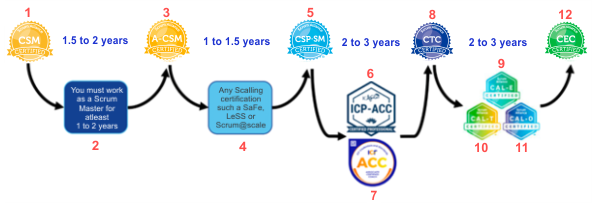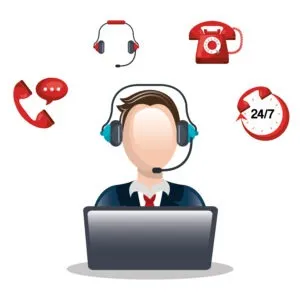
Scrum Master to Agile Coach path
If you are already working as a Scrum Master and if you are looking for career growth towards becoming an Agile Coach, this article is for you to help achieve your goal.
Firstly, you should know the difference between a Scrum Master and an Agile Coach. Below table gives you a brief about the differences between Scrum Master and an Agile Coach.
Scrum Master | Agile Coach |
Focus is mostly on the Scrum Team level | Focus is beyond team level (Organization) |
Supports Single Team | Supports Scrum Masters, Product Owners and Leaders and Agile adoption |
Takes care of team processes, practices, tools | Takes care of organizational transformation |
Works within Scrum framework | Able to suggest other frameworks to improve agility |
Certifications are helpful to support in your career progression. They help you to enhance your knowledge through an authorized source of knowledge and that knowledge expedited your career growth. So there are some certifications we are recommending in this article. One important point, stick to one certification organization (such as Scrum Alliance or Scrum.org or Scrum.inc) because it helps you plan your growth through their continued certifications levels. In this article we are providing a path taking Scrum Alliance certifications along with some additional organizations also.
Please note the below certifications are recommended based on our own experience which has worked for our trainers, coaches and few of our participants. This may not a universally applicable certification path.

Each certification has been given a sequence number and below is a brief explanation of the path that explains each of the steps.
1. Certified Scrum Master (CSM): This is the first step to understand what is Scrum framework and Agile values and principles. You will get fundamentals of Scrum with Scrum Team, Scrum Events, Scrum Artifacts, Scrum Values etc. This enables you to be a Scrum Master and solve complex problems using Scrum with a single Scrum Team. Learnovative offers multiple weekend and weekday CSM workshops and you can find them in our calendar at: https://www.learnovative.com/training-calender
2. Experience with Scrum: Once you become a certified Scrum Master, your immediate next step is to start working as “Scrum Master” for at least 1.5 to 2 years. This experience helps you to understand practical implementation of Scrum and lets you gain knowledge on how to solve practical issues in implementing Scrum.
3. Advanced Certified Scrum Master (A-CSM): In A-CSM, you get knowledge of various other Agile frameworks, how to resolve conflicts, working with multi-team Scrum, practical coaching and facilitation hands-on experience. Learnovative offers multiple weekend and weekday A-CSM workshops and you can find them in our calendar at: https://www.learnovative.com/training-calender
4. Scaling Scrum certification: Once you get fundamentals of multi-team Scrum with A-CSM you take any scaling framework certification that helps you gain an in-depth understanding of how scaling Scrum works with hands-on case studies. You may choose SAFe (Scaled Agile Framework) or LeSS (LArge Scale Scrum) or S@S (Scrum at Scale.
5. Certified Scrum Professional – Scrum Master (CSP-SM): This helps you learn how Lead and Agile complement each other, advanced facilitation and coaching techniques, team dynamics, organizational development and advanced scaling approaches.
6. ICAgile Certified Practitioner – Agile Coaching Certification (ICP-ACC): This primarily focuses on understanding Agile coaching competencies at team level and organizational level coaching. Various agile coaching techniques will be taught with hands-on practice.
7. International Coaching Federation – Associate Certified Coach (ICF-ACC): This helps you understand professional coaching competencies and helps you get access to understand how a professional coach works to help their clients. You will get thorough knowledge on the coaching competencies because you have to practice a minimum 100 hours of coaching conversations before you get the certification. You will practice professional coaching models such as: GROW, WONDER, ADKAR in this practice.
8. Certified Team Coach (CTC): This is the major first step to become an enterprise Agile coach. Based on the knowledge and experience you gain in the last 7 steps, you will go through the CTC process. This is not just a few days or training. You will have to go through 2 stages of the application process where there will be plenty of subjective questions you have to answer based on your experience of Scrum master and agile coach experience. After validating your answers the Scrum Alliance will award the CTC certification.
9. Certified Agile Leadership – Essentials (CAL-E): This is a one day training in which you will get to know Agile LEadership fundamentals including types of leaderships, types of leaders and their characters, how they think, behave etc. The focus on agile leadership essentials helps you to grow confidently on the journey towards leading with agility and participating in agile transformation in an organization.
10. Certified Agile Leadership – for Teams (CAL-T): Agile teams need an alternative to the traditional old age leadership approaches. CAL for Teams demonstrates how to develop a safe-to-fail environment and create a culture of transparency, inspection, and adaptation to allow for empirical and continuous learning within your teams.
11. Certified Agile Leadership – for Organization (CAL-O): Executive level leaders (CxOs) are now required to shift the way that they think about their organizational culture and employees. They need to become real change agents. In CAL for Organizations, you will gain knowledge, skills, and techniques that will help leaders to work toward sustainable agility for their organizations. It helps you understand various organizational types, cultures and how you can help them to be agile organizations.
12. Certified Enterprise Coach (CEC): This is the ultimate agile coaching certification from the Scrum Alliance. This helps you become an enterprise agile coach who helps organizations in their agile transformation. With all the prior 11 steps you have accomplished will provide required support to become CEC. This is again not a training based certification. You have to go through two stages of application (similar to CTC) and then demonstrate your practical abilities and knowledge.
General Guidelines:
- Stick to one organization based certifications. This is because it helps you renew your existing certifications whenever you do a higher certification with the same organization. This will save considerable amount of money
- Do not go for back to back certifications just for the sake of getting a certification. You need to maintain enough time to gain experience on top of your previous certification before going for the next level
- You have to keep some time reserved from your day to day office related activities to achieve your certifications
- Join the community groups available for the certifications so that you get to know valuable information and tips
- Be active in social media such as linked in to share your knowledge, thoughts. For few certifications such as CTC and CEC they check for your contribution in the agile community
- Become part of user groups or you start your own user group and develop that group
- Participate in conferences, meetups and webinars in order to get knowledge and information for your journey
- Find a mentor after you become CSP-SM so that your mentor will guide you towards your final goal
- Read books frequently related to Agile, Scrum, Leadership and Organizations
- Last but not least, you need to have patience and be able to spend time to move forward in your path explained above. So be patient and do not lose hope.
Recent Posts
- Essential Metrics to Measure Scrum Team Performance 17/04/2024
- How to influence without Authority? 17/04/2024
- Impact Mapping Example 08/04/2024
- Business Agility Vs Organizational Agility Vs Enterprise Agility 08/04/2024
- Agile Vs agile vs Agility 28/03/2024

